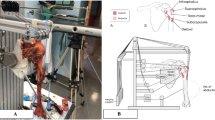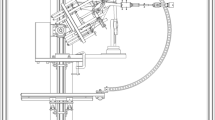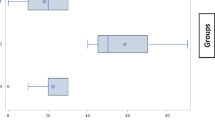Abstract
Background
After rotator cuff repair, some surgeons use abduction pillows to unload or protect the repair construct, while others do not.
Question/Purpose
The aim of this study was to determine which type of sling—one with a small or large abduction pillow or one without a pillow—places the repaired rotator cuff in the best position to reduce tension on the supraspinatus.
Methods
An X-ray study was performed on asymptomatic subjects to determine what position the shoulder is placed in when wearing a sling with or without an abduction pillow. Positions were then reproduced in human cadaveric shoulders using a custom-made testing jig, and tension on the repaired supraspinatus was measured.
Results
X-rays showed that abduction of the glenohumeral joint with a sling was only 4°, with a sling with a small pillow was 13°, and with a sling with a large abduction pillow was 25°. Placing the cadaveric shoulders in the position of a sling with a small abduction pillow caused a reduction in tension on the supraspinatus of 27% anteriorly and 55% posteriorly compared to placing the shoulder in the position of a sling without an abduction pillow; a large abduction pillow caused a further reduction in tension, of 42% anteriorly and 56% posteriorly.
Conclusion
These findings show that abduction pillows reduce tension on the repaired supraspinatus tendon.




Similar content being viewed by others
References
Ahmad CS, Kleweno C, Jacir A, Bell J, Gardner T, Levine W, et al. Biomechanical performance of rotator cuff repairs with humeral rotation. Am J Sports Med. 2008;36(5):888–92.
American Academy of Orthopaedic Surgeons. Optimising the management of rotator cuff problems. American Academy of Orthopaedic Surgeons Clinical Practice Unit. 2010.
Andarawis-Puri N, Kuntz AF, Ramsey ML, Soslowsky LJ. Effect of glenohumeral abduction angle on the mechanical interaction between the supraspinatus and infraspinatus tendons for the intact, partial-thickness torn, and repaired supraspinatus tendon conditions. J Orthop Res. 2010;28(7):846–851.
Andres BM, Lam PH, Murrell GAC. Tension, abduction, and surgical technique affect footprint compression after rotator cuff repair in an ovine model. J Shoulder Elb Surg. 2010;19(7):1018–1027.
Bey MJ, Song HK, Wehrli FW, Soslowsky LJ. Intratendinous strain fields of the intact supraspinatus tendon: the effect of glenohumeral joint position and tendon region. J Orthop Res. 2002;20(4):869–874.
Bigliani L, Cordasco F, McIlveen S, Musso E. Operative treatment of failed repairs of the rotator cuff. J Bone Joint Surg. 1992;74-A(10).
Fleiss J. Design and analysis of clinical experiments. New York: John Wiley and Sons. 1986.
Hersche O, Gerber C. Passive tension in the supraspinatus musculotendinous unit after long-standing rupture of its tendon: a preliminary report. J Shoulder Elb Surg. 1998;7(4):393–396.
Howe C, Huber P, Wolf FM, Matsen F. Differential suture loading in an experimental rotator cuff repair. Am J Sports Med. 2009;37(2):324–329.
Park MC, Pirolo JM, Park CJ, Tibone JE, McGarry MH, Lee TQ. The effect of abduction and rotation on footprint contact for single-row, double-row, and modified double-row rotator cuff repair techniques. Am J Sports Med. 2009;37(8):1599–1608.
Pedowitz RA, Yamaguchi K, Ahmad CS, et al. American Academy of Orthopaedic Surgeons Clinical Practice Guideline on: optimizing the management of rotator cuff problems. J Bone Joint Surg (Am Vol). 2012;92(2):163–167.
Rathbun J, Macnab I. The Microvascular Pattern of the Rotator Cuff. J Bone Joint Surg Br Vol. 1970;52-B(3):540–553.
Reilly P, Bull AMJ, Amis AA, et al. Passive tension and gap formation of rotator cuff repairs. J Shoulder Elb Surg. 2004;13(6):664–7.
Rothman RH, Parke WW. The vascular anatomy of the rotator cuff. Clin Orthop Relat Res. 1965;41:176–186.
Funding
The researchers received internal department funds from the Orthopaedic Research Institute, St. George Hospital, University of New South Wales, Sydney, Australia.
Author information
Authors and Affiliations
Corresponding author
Ethics declarations
Conflict of Interest
Jacqueline R. Hawthorne, MD; Elise M. Carpenter, MD; and Patrick H. Lam, PhD, report that they have no conflict of interest. George A.C. Murrell, MD, DPhil, reports receiving grant support and fees as a consultant from ArthroCare Corporation.
Human/Animal Rights
All procedures followed were in accordance with the ethical standards of the responsible committee on human experimentation (institutional and national) and with the Helsinki Declaration of 1975, as revised in 2013.
Informed Consent
Informed consent was waived from all patients for being included in this study.
Required Author Forms
Disclosure forms provided by the authors are available with the online version of this article.
Rights and permissions
About this article
Cite this article
Hawthorne, J.R., Carpenter, E.M., Lam, P.H. et al. Effects of Abduction Pillows on Rotator Cuff Repair: A Biomechanical Analysis. HSS Jrnl 14, 114–122 (2018). https://doi.org/10.1007/s11420-017-9592-2
Received:
Accepted:
Published:
Issue Date:
DOI: https://doi.org/10.1007/s11420-017-9592-2




